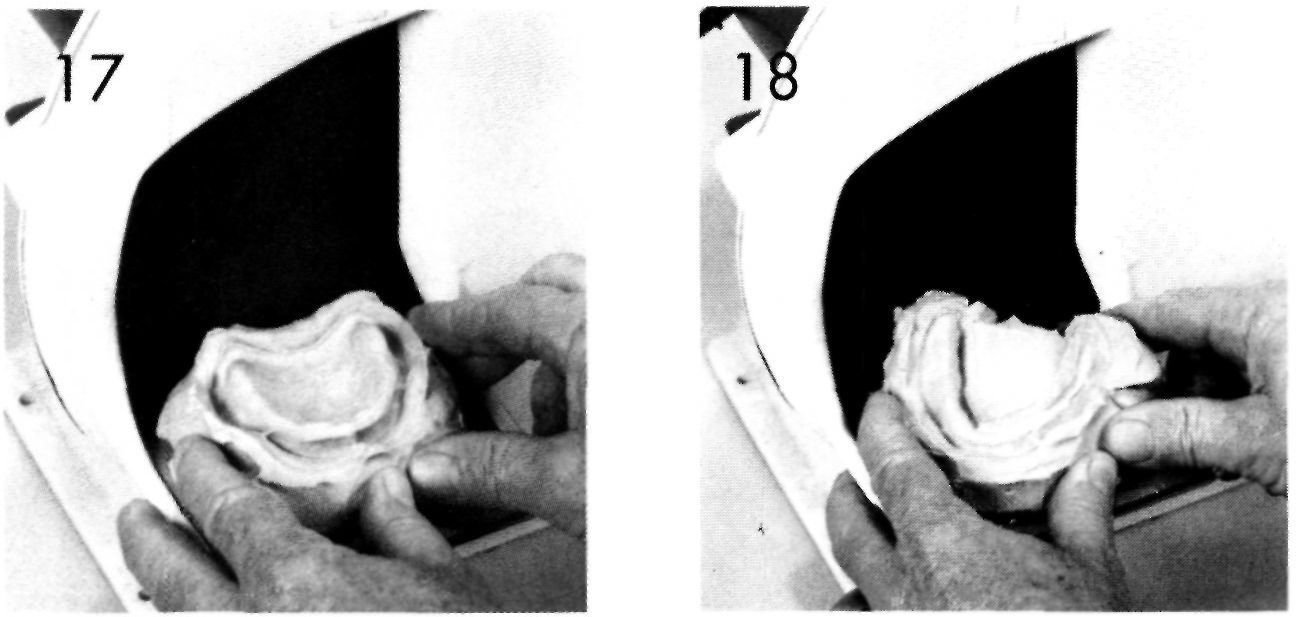
POURING FINAL IMPRESSIONS AND INVERTING
Figure 1 These final impressions have been made of zinc oxide-eugenol paste and are shown as they arrive from the dentist’s office.
Figure 2 This drawing illustrates the proper placement of the wax bead on the final impression. It is placed at the greatest height of contour on the outside border of the denture. If there is any question as to the placement of this bead, it should be placed so that there will be a greater amount of the border showing. If it is placed too far away from the border, it is a simple matter to trim the cast. If it is placed too close to the border, the cast may be unsatisfactory.
Figure 3 The wax bead is adapted to the maxillary impression. The wax used in this illustration is a square rope of utility wax which adheres to the zinc oxide-eugenol impression material.
Figure 4 The beading is completed for the maxillary impression. Note that the beading across the posterior border of the denture does not cover any tissue surface, but rather preserves the posterior border of the impression.
Figure 5 The beading is completed on the mandibular impression. Note the amount of the impression border which is visible below the beading wax. None of the tissue surface is covered by the beading wax.
Figure 6 The beading has been completed for the maxillary and mandibular impressions. Note the piece of baseplate wax which has been placed in the tongue space of the mandibular impression. The wax is on the inferior side of the wax bead but does not touch the impression surface. This piece of baseplate wax will produce a smooth tongue space on the completed cast and will eliminate the need for trimming in this area. Note that none of the tissue surface in either the mandibular or maxillary impression is covered by the beading wax.


Figure 7 The stone is mixed thoroughly to a thick consistency to insure a strong, dense cast.
Figure 8 The beaded impression is held on the vibrator as is illustrated, and the stone is placed into one corner of the impression allowing the stone to flow around the impression so that air is not trapped. The stone will flow more readily if the impression is damp, not dry. The impression is filled with stone in this manner.
Figure 9 A mound or patty of stone is placed on a glass slab. The filled impression is then inverted onto the patty of stone. It should be placed firmly but gently into the patty so that the poured part of the impression adheres firmly to the patty of stone. The impression is pressed until the deepest part of the impression is approximately one-half inch from the glass slab. This will produce a cast which is one-half inch thick in its thinnest area. The impression should be parallel to the glass slab.
Figure 10 After the impression is positioned, the spatula is used to pull some stone up around the wax bead. Very little manipulation is necessary. The cast is then allowed to set before any further work is done on it. Note that the stone was mixed to a consistency such that it did not flow over the glass slab.
Figure 11 A similar procedure is used to pour the mandibular impression using a vibrator. The stone is placed in one side of the impression, and is allowed to run to the opposite side. The impression is filled in a manner similar to that used for the maxillary impression.
Figure 12 A patty of stone is placed on the glass slab as was done with the maxillary impression. The mandibular impression is inverted onto the patty and the stone is pulled up around the wax beading. When using this method for pouring master casts, it is essential that enough stone be placed on the posterior part of the poured impression as is shown in this illustration. Note that a thick mix of stone is essential.
Figure 13
Stay updated, free dental videos. Join our Telegram channel

VIDEdental - Online dental courses




